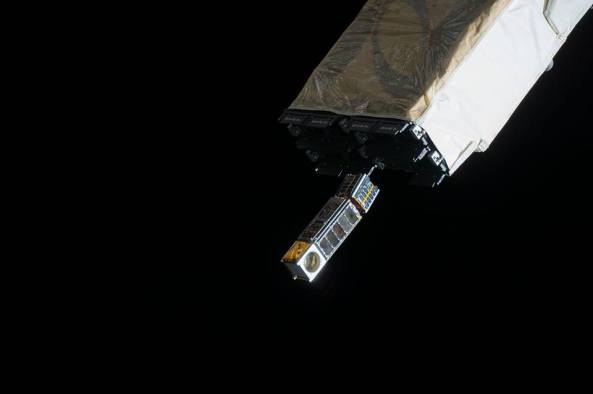
Some of the Lambda-Sat Team (right to left) Dr. Periklis Papadopoulos, Kostas Alexandrou, Eriana Panopoulou, Vaggelis Christodoulou, Maria Dimitrakopoulou, Charalabos Koulouris and Simos Kanis
Lambda-Sat was launched to the International Space Station (ISS) from the Wallops Flight Facility in Virginia on July 13, 2014, in an Orbital Sciences’ Antares rocket CRS-2/ORB-2.
UPDATE: Deployment from the ISS took place on March 4, 2015 along with the MicroMAS CubeSat. This followed the deployment of two other CubeSats GEARRSAT and TechEdSat-4. On May 16, 2015 Lambda-Sat reentered the Earth’s atmosphere and burnt up. No signal was ever reported from Lambda-Sat.
The Lambda team encourages amateur radio operators around the world to listen for and report the Lambda-Sat signal. Frequency: 437.462 MHz Downlink: AX.25 Unnumbered Information (UI) packets at 1200 bps AFSK Transmission Power : 1W Call Sign KK6DFZ The Secretary of the Cyprus Amateur Radio Society (CARS) Nestor has written an article on Lambda-Sat, he says: The naming of the Λ-sat satellite came from the Greek letter L (Λ – lambda) a reminder of Hellas, Helios, the Greek word Thalassa for sea, the Greek word Lithos which directly translates to stone (meaning “Land of Light”).
The Λ-sat was constructed entirely of Greek volunteers who worked feverishly, selflessly and without any personal gain. Members of Λ-sat contributed to the construction of the satellite system each with their knowledge in robotics, electronics, software development and telecommunications. The group consists of young people from Greece who traveled to Silicon Valley in California to participate in this project. “I want to motivate the youth in Greece to continue to dream,” says the original initiator of the project, Periklis Papadopoulos, Professor of Aerospace Engineering of the Federal University of California San Jose, which has been awarded from NASA for his contribution with the prize Turning Goals Into Reality (TGIR). As the professor states, “My goal is to demonstrate the capabilities of young people in Greece.” The professor believes that our country could be active in this area and this is not an economic issue, but a question of will alone (!). Submit reception reports of Lambda-Sat at http://lambdasat.com/?page_id=181 Lambda-Sat http://lambdasat.com/ Facebook https://www.facebook.com/lambdateam Article on Lambda-Sat by http://www.cyhams.org/index.php/en/news-and-events/359-the-first-greek-microsatellite-is-a-fact



You must be logged in to post a comment.